Related Research Articles

Comet Giacobini–Zinner is a periodic comet in the Solar System. It was discovered by Michel Giacobini, who observed it in the constellation of Aquarius on 20 December 1900. It was recovered two orbits later by Ernst Zinner, while he was observing variable stars near Beta Scuti on 23 October 1913.
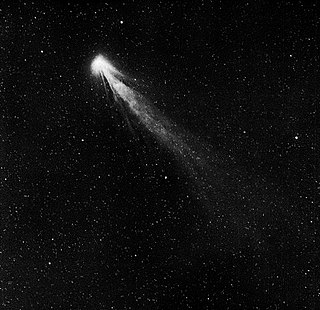
Comet Humason, formally designated C/1961 R1, was a non-periodic comet discovered by Milton L. Humason on 1 September 1961. Its perihelion was well beyond the orbit of Mars, at 2.133 AU. The outbound orbital period is about 2,516 years.
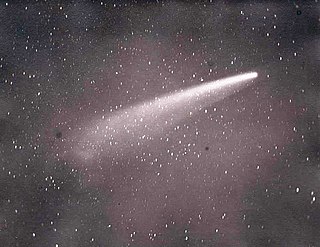
The Great Comet of 1882, formally designated as C/1882 R1, 1882 II, and 1882b, was a comet which became very bright in September 1882. It was a member of the Kreutz Sungrazers, a family of comets which pass within 1 R☉ of the Sun's photosphere at perihelion.

52P/Harrington–Abell is a periodic comet in the Solar System.
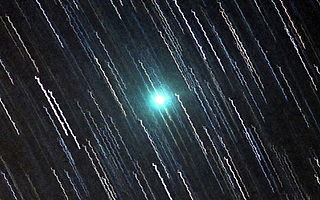
Comet IRAS–Araki–Alcock is a long-period comet that, in 1983, made the closest known approach to Earth of any comet in the last 200 years, at a distance of about 0.0312 AU.
The Comet of 1729, also known as C/1729 P1 or Comet Sarabat, was an assumed parabolic comet with an absolute magnitude of −3, possibly the brightest ever observed for a comet; it is therefore considered to be potentially the largest comet ever seen. With an assumed eccentricity of 1, it is unknown if this comet will return in a hundred thousand years or be ejected from the Solar System.
C/1702 H1, also known as the "Comet of 1702", is a comet discovered by Maria Margaretha Kirch in Germany on April 20, 1702.

C/1992 J1 (Spacewatch) is a comet that was discovered 1 May 1992 by David Rabinowitz of the Spacewatch Project. This was the first comet to be discovered using an automated system.
C/2001 OG108 (LONEOS) is a Halley-type comet with an orbital period of 48.51 years. It was discovered on 28 July 2001 by the LONEOS telescope at Lowell Observatory. Of the short-period comets with known diameters and perihelion inside the orbit of Earth, C/2001 OG108 is the second largest after Comet Swift–Tuttle.
The JPL Small-Body Database (SBDB) is an astronomy database about small Solar System bodies. It is maintained by Jet Propulsion Laboratory (JPL) and NASA and provides data for all known asteroids and several comets, including orbital parameters and diagrams, physical diagrams, close approach details, radar astrometry, discovery circumstances, alternate designations and lists of publications related to the small body. The database is updated daily when new observations are available. In April 2021 the JPL Small-Body Database started using planetary ephemeris (DE441) and small-body perturber SB441-N16. Most objects such as asteroids get a two-body solution (Sun+object) recomputed twice a year. Comets generally have their two-body orbits computed at a time near the perihelion passage as to have the two-body orbit more reasonably accurate for both before and after perihelion. For most asteroids, the epoch used to define an orbit is updated twice a year. Orbital uncertainties in the JPL Small-Body Database are listed at the 1-sigma level.
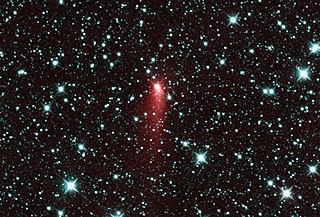
C/2013 UQ4 (Catalina) is a Solar System comet that came close to the Earth on July 10, 2014, at a distance of 0.314 AU (47,000,000 km; 29,200,000 mi).

C/2015 ER61 (PanSTARRS) is a comet and inner Oort cloud object. When classified as a minor planet, it had the fourth-largest aphelion of any known minor planet in the Solar System, after 2005 VX3, 2012 DR30, and 2013 BL76. It additionally had the most eccentric orbit of any known minor planet, with its distance from the Sun varying by about 99.9% during the course of its orbit, followed by 2005 VX3 with an eccentricity of 0.9973. On 30 January 2016, it was classified as a comet when it was 5.7 AU from the Sun. It comes close to Jupiter, and a close approach in the past threw it on the distant orbit it is on now.

C/2017 T1 (Heinze) is a hyperbolic comet that passed closest to Earth on 4 January 2018 at a distance of 0.22 AU (33 million km).

C/2016 R2 (PanSTARRS) is a comet, discovered using the Pan-STARRS telescopes on September 7, 2016. The comet attracted attention from many astronomers as it approached its closest point to the Sun in May 2018. It has been observed to have a very complex tail, which has been suggested to be due to a fast rotation period of the nucleus.

205P/Giacobini is a periodic Jupiter-family comet with an orbital period of 6.68 years. It was discovered by Michel Giacobini on 4 September 1896 and then it was lost until it was recovered by Koichi Itagaki on 10 September 2008. The comet was then found to have fragmented into three pieces.
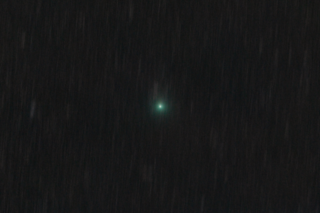
C/2018 Y1 (Iwamoto) is a long period comet with a retrograde orbit discovered on 18 December 2018, by Japanese amateur astronomer Masayuki Iwamoto. Its period is estimated to be 1,733 years. It passed closest to Earth on 13 February 2019. It was expected to reach a magnitude of between 6.5 and 7.5, visible in binoculars or a small telescope and was reported to reach a magnitude of 5.5 by Juan Jose Gonzalez on February 13, before fading to 7.6 two weeks later.

C/2019 U6 (Lemmon), or Comet Lemmon is a long period comet with a near-parabolic orbit discovered by the Mount Lemmon Survey on October 31, 2019. It made its closest approach to the Sun on June 18, 2020. In June 2020 it was visible near the naked eye limit at an apparent magnitude of 6.0. It is the 3rd brightest naked eye comet of 2020 after C/2020 F3 (NEOWISE) and C/2020 F8 (SWAN). It remained visible near the naked eye limit in June.

C/2020 F5 (MASTER) is a non-periodic comet discovered on 28 March 2020, by the MASTER auto-detection system near San Juan, Argentina.
Comet Tago–Honda–Yamamoto, formally designated C/1968 H1, is a retrograde non-periodic comet discovered by Akihiko Tago, Minoru Honda, and Hirofumi Yamamoto on 1 May 1968. Although officially named after the three Japanese astronomers, it was actually first spotted by Kōichi Itagaki about five days earlier on 25 April 1968, however he could not report his sighting for another couple of weeks.
Dubiago's Comet, formally known as C/1921 H1 by its modern nomenclature, is a faint Halley-type comet that completes an orbit around the Sun once every 61–79 years. It was predicted to return in 1982, but it was not observed. It will next return to the inner Solar System by 2041.
References
- ↑ "C/1998 H1 (Stonehouse) – JPL Small-Body Database Lookup". ssd.jpl.nasa.gov. Jet Propulsion Laboratory . Retrieved 7 November 2024.
- 1 2 S. Yoshida. "C/1998 H1 ( Stonehouse )". www.aerith.net. Retrieved 19 April 2018.
- ↑ Nemiroff, R.; Bonnell, J., eds. (14 May 1998). "Comet Stonehouse". Astronomy Picture of the Day . NASA . Retrieved 19 April 2018.

